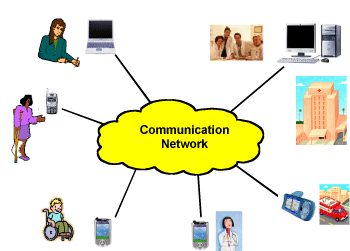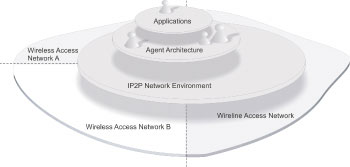CASCOM - Context-Aware Health-Care Service Co-ordination in Mobile Computing Environments
by César Cáceres, Alberto Fernández, and Sascha Ossowski
The field of telemedicine is one of the fastest growing application areas for intelligent mobile services. Scientists at University Rey Juan Carlos, Madrid, are developing an open infrastructure for business application services across mobile and fixed networks. This project, known as CASCOM (Context-Aware Business Application Service Coordination in Mobile Computing Environments), is funded by the European Commission's FP6 IST programme. CASCOM will deliver a demonstrator for medical emergency assistance that accounts for the on-the-fly coordination of pervasive health care services.
Since its creation, the Internet has revolutionized many aspects of our life. Like many other fields, telemedicine has benefited from the ubiquitous access to (medical) knowledge granted by the Internet. Nowadays, a patient can be monitored without needing to be moved to a health-care centre. In addition, there is potential for improved diagnosis and treatment, through the transfer of patient records from one hospital to another, for instance. Two requirements are crucial to the field: the interoperability of medical information systems and electronic health records on the one hand, and the security and privacy of personal information on the other.
Until recently however, it was necessary to have at least a personal computer physically linked to a fixed wired network, a fact that severely restricted the mobility of users of telemedicine applications. Still, the latest advances in wireless and mobile technologies (eg Bluetooth, WiFi, GPRS and UMTS) have overcome this limitation. Furthermore, the availability and popularity of small mobile devices (eg PDAs, mobile phones, GPS and medical devices) have created a plenty of opportunities for increased user mobility in the field.
It is therefore not surprising that telemedicine is one of the fastest-growing application fields for intelligent mobile services. Nevertheless, a significant number of new challenges have come up. In particular, certain technological and domain constraints (computational and bandwidth limitation, security and privacy concerns etc) must be taken into account in order to successfully build open, large-scale, pervasive applications for the health-care domain.
|
These challenges are now being addressed by CASCOM. To this end, we are developing value-added supportive infrastructures for business application services to be employed by mobile workers and users across mobile and fixed networks. The CASCOM approach is the innovative combination of intelligent agent technology, semantic Web services, peer-to-peer and mobile computing for intelligent peer-to-peer (IP2P) mobile service environments. IP2P represents an extension to conventional P2P architectures, with components for mobile and ad hoc computing, wireless communications, and a range of pervasive devices.
The CASCOM architecture is organized into three layers:
Network Layer: this layer provides a generic, secure and open IP2P network infrastructure, taking into account the varying quality of service of wireless communication paths, the limitations of resource-poor mobile devices, and the contextual variability of nomadic environments.
Service Coordination Layer: this layer uses agent technology for flexible semantic Web service discovery, dynamic context-aware semantic Web service composition, fault-tolerant interleaving of planning and service execution, and secure service execution and monitoring providing service data consistency.
Application Layer: this layer gives CASCOM applications functionality in a variety of business service scenarios. In particular, a demonstration will be developed for the healthcare domain that includes:
- the integration of business process models of medical experts across Europe
- the provision and coherent integration of distributed patient records
- the development of methods for maintaining application semantics along the business process models that in turn are based on service agents and semantic Web service descriptions.
In the application layer, particularly for healthcare scenarios, we plan to use W3C standard OWL and OWL-S when describing semantic Web application services. These standards will be also used in the service coordination layer and IP2P network layer wherever applicable. In implementing the agent-based service coordination layer and IP2P network layer service agents, FIPA standards - in particular those related to agent communication and management - will be followed. FIPA application standards (eg Nomadic Application Support) will be used in the IP2P network layer, while the IP2P transport layer will be based on IETF standards such as HTTP and TCP. Further, throughout the CASCOM architecture, UML and AUML will be used in the design of architecture components.
Although the CASCOM architecture is not expressly designed for a specific application, its primary field of validation is the telemedicine domain and the on-the-fly coordination of pervasive healthcare services. In particular, a prototype for medical emergency assistance will be designed, implemented, and evaluated. It is worthwhile pointing out, however, thatin addition to the health-care domain, we will ensure that CASCOM's innovative project technology is applicable to a variety of other business application scenarios, including personal assistance, virtual enterprises and entertainment (eg distributed games and other interactive settings).
The CASCOM consortium consists of DFKI (Germany), TeliaSonera AB (Sweden), EPFL (Switzerland), ADETTI (Portugal), URJC (Spain), EMA (Finland), UMIT (Austria) and FrameTech (Italy). This article reports on joint work being undertaken by the consortium. The authors would like to thank all partners for their contributions.
Link:
CASCOM: http://www.ist-cascom.org/
Please contact:
César Cáceres, Alberto Fernández and Sascha Ossowski University Rey Juan Carlos, Madrid, Spain
E-mail: {ccaceres, al.fernandez, s.ossowski}![]() escet.urjc.es
escet.urjc.es

 This issue in
This issue in 

